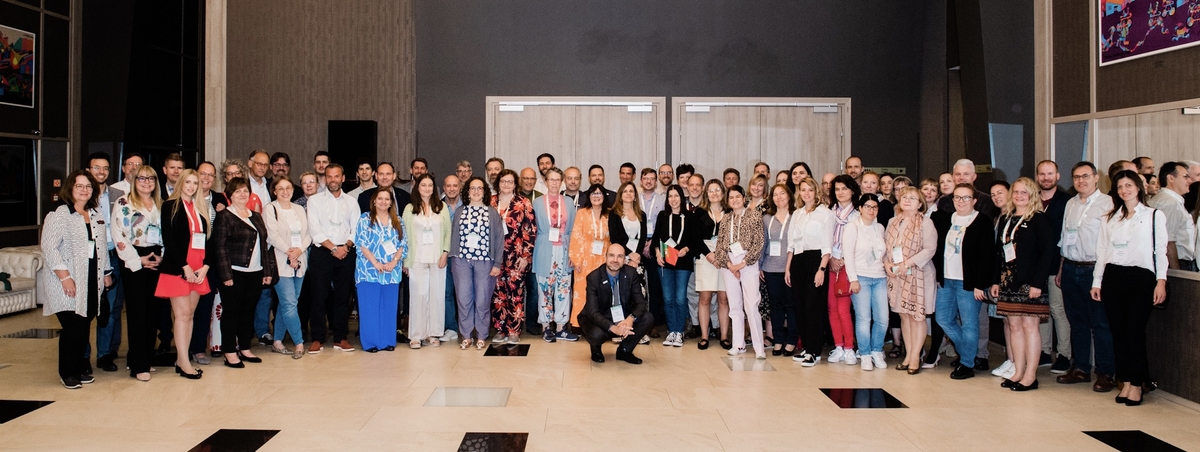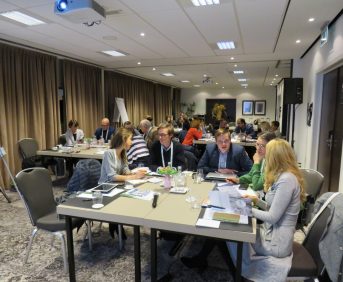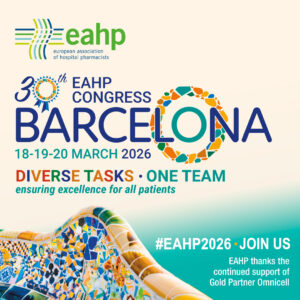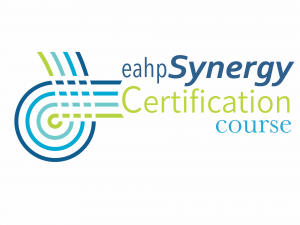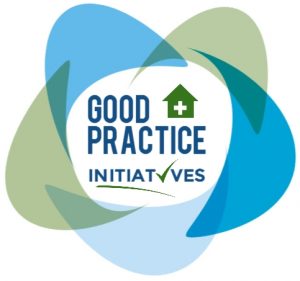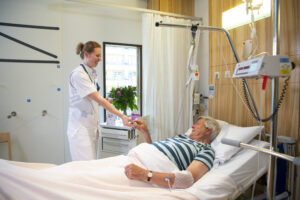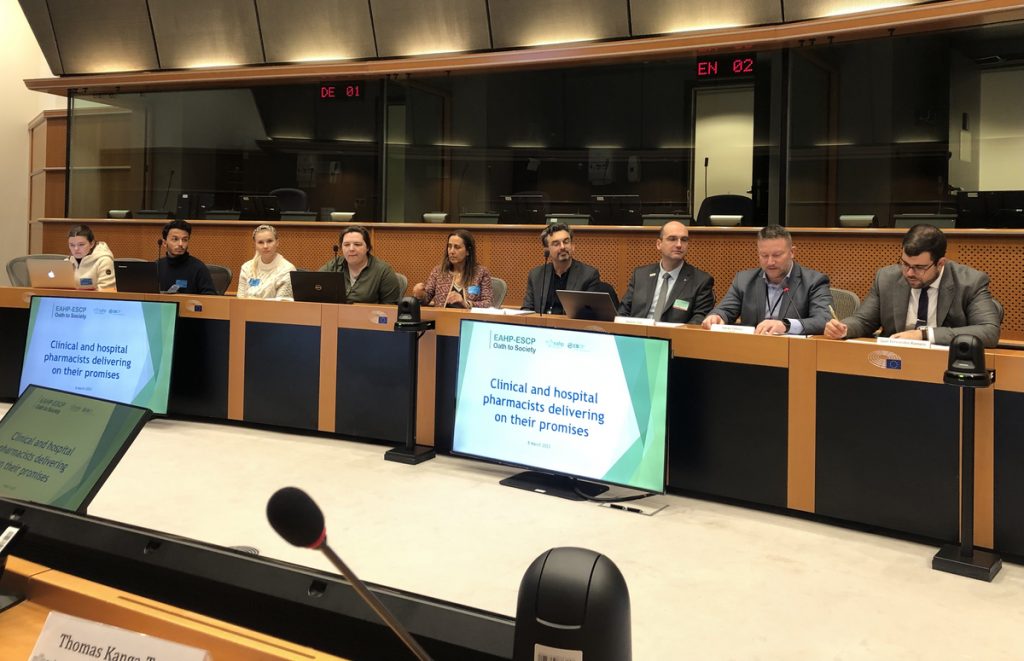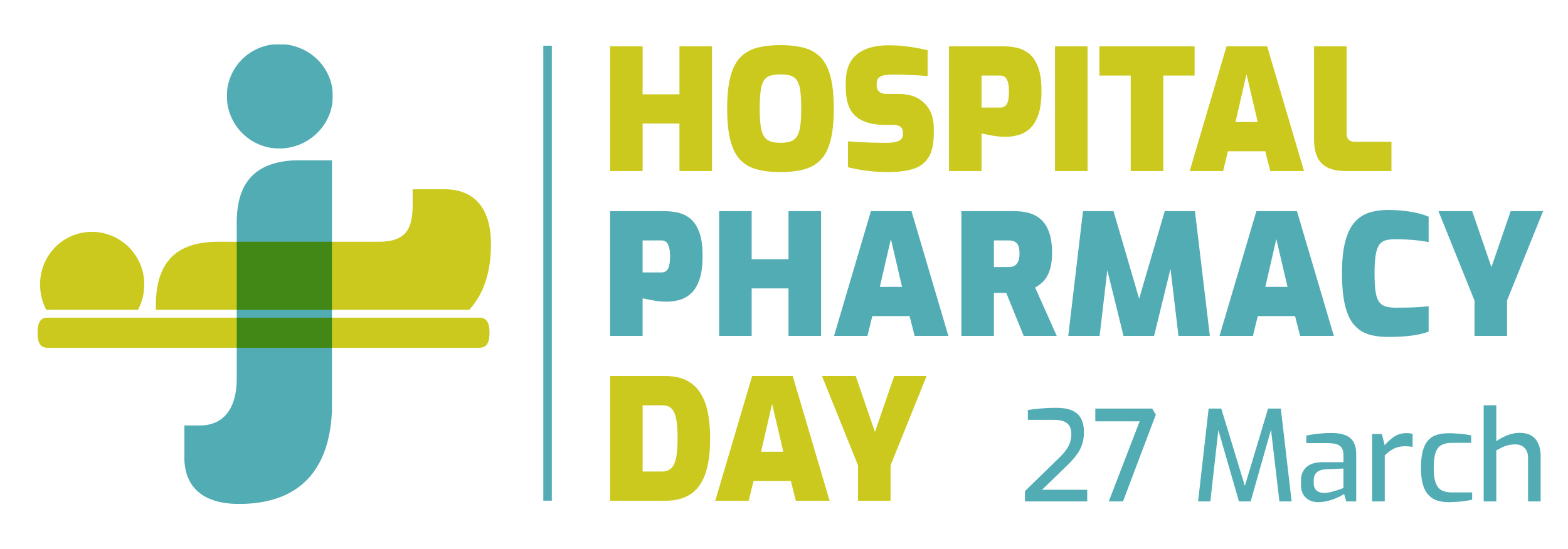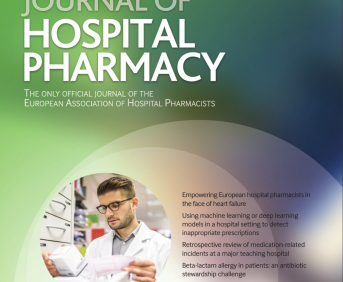Evaluation of tetracosactide peptide in galenic formulations for rapid adrenocorticotrophic hormone stimulation test
Pdf

European Statement
Production and Compounding
Author(s)
Aleksandra Bračko, Janez Ilaš
Why was it done?
The rapid adrenocorticotrophic hormone (ACTH) stimulation test is a commonly performed test in all hospital departments of the University Medical Centre Maribor. The reason for its widespread use lies in its simple execution using a pre-filled syringe containing precisely 1 µg of tetracosactide solution. Until the year 2016, we prepared a 5 ml solution with a concentration of 5 µg/ml in glass vials. Based on a literature data we set a shelf life of three months from the date of production for the solution filled in plastic syringe. The solution in glass vials has a shelf life of four months. We wanted to confirm this shelf-life with several analytical methods.
What was done?
The aim of our work was the qualitative and quantitative evaluation of tetracosactide peptide in a solution with a concentration of 5 µg/ml, filled in glass and plastic containers and stored under different conditions, using multiple methods. We stored the sample solution of tetracosactide for five months under various conditions. We performed the analysis using the Qubit 4 fluorometer, the Bradford method and method based on ultra-high-performance liquid chromatography coupled to high-resolution mass spectrometry (UHPLC–HRMS).
How was it done?
The first two relatively simple methods, Qubit 4 fluorometer, the Bradford method, did not provide the desired results. We assume that these methods were not sensitive enough for our sample with a concentration of 5 µg/ml. In the end, we used the UHPLC-HRMS analysis, which proved to be sensitive and highly selective.
What has been achieved?
The peptide molecule has eight basic centers in its structure, so both tetracosactide and each impurity were differently charged in an acidic medium, specifically +3, +4, +5, +6, +7, and +8. The distribution of charge of tetracosactide and impurities among the samples is very similar, with the highest proportion represented by molecules with a charge of +6. We have identified 11 impurities. The highest proportion was represented by impurity with the increased mass of 16 Da (tetracosactide sulfoxide). HPLC-HRMS method is highly selective and allows identification of each impurity
What next?
Based on the findings we will validate a method for quantification of the selected impurities which will allow us to perform the stability study of according to the ICH guidelines.
A risk-based choice of syringes and associated equipment for compounding and intravitreal administration of drugs for wet age-related macular degeneration
Pdf

European Statement
Production and Compounding
Author(s)
Espen Gleditsch, Dag Fossum
Why was it done?
There are no available syringes with CE approval for intravitreal administration. The CE approval for sterile single use syringes covers dosage and sterility, but not the special needs associated with intravitreal administration. The choice of syringe and associated equipment therefore have to be based on a risk assessment. The intravitreal administration includes increased patient risk regarding sterility (infection), particles (inflammation), injection volume (ocular pressure), silicone oil (floaters in the vision) and technical performance (leakage and compatibility with needle). The aim of this work was to find the syringes, associated equipment and compounding process that present least risk to the patients.
What was done?
Oslo hospital pharmacy delivers ready to use syringes for intravitreal administration of drugs for wet age-related macular degeneration. The pharmacy has in cooperation with the eye department at Oslo university hospital done a risk assessment in 2023 to decide syringes and associated equipment for compounding and administration.
How was it done?
The syringes historically used for intravitreal administration in Norway are Insulin syringes with prefixed needles (BD), Inject F syringes (BBraun) and Zero Residual syringes (SJJ Solutions). The needles used are TSK Low Dead Space needles and Zero Residual needles. The compounding methods are filling of the ready to use syringe from a bulk syringe by a needle or use of a Zero Residual bubble adaptor. All ready to use syringes are compounded in isolators with grade A in the working chamber, delivered with needle or cap, and packed in sterile bags. The risks associated with each syringe, needle and compounding process were assessed with a Failure Mode Effects Analysis Method.
What has been achieved?
The risk assessment shows that the risk to the patients are lowest when administering drugs for wet age-related macular degeneration with Zero Residual syringes and needles, filling the syringes with bubble adaptor and deliver with cap. This will give the lowest risk score regarding sterility, particles, injection volume, silicone oil and technical performance.
What next?
This work is relevant for other pharmacists and prescribing practitioners when assuring that syringes and associated equipment are of appropriate quality and suitable for intended use.
Electronic prescription protocols for personalised sterile preparations for the paediatric surgery department
Pdf

European Statement
Production and Compounding
Author(s)
Isabel María Carrión Madroñal, Concepción Álvarez del Vayo Benito , Begoña Balboa Huguet , Santiago Lora Escobar , Paloma Barriga Rodríguez
Why was it done?
-Improve security, planning, and access to information for correct prescription, administration, and management.
-Guarantee the traceability of all processes.
-Improve the satisfaction of the services involved, preventing forgetfulness and therefore management of emergency calls, unjustified need for the prescribed preparations, and incorrect packaging.
-Improve communication and the work circuit from PD.
What was done?
To prepare a protocol with the processes of prescription, validation, preparation and dispensing of personalised sterile formulations in the Paediatric Surgery Department (PSD: Otorhinolaryngology, Ophthalmology and Neurosurgery) from the Pharmacy Department (PD).
How was it done?
1. Creation of a multidisciplinary team in which a circuit for the prescription, validation, preparation and dispensing of sterile preparations was agreed.
2. Analysis with the departments involved of the personalised sterile-medications prepared by PD for use in paediatric-surgical-rooms, and the most frequent doses used.
3. Bibliographic review: PubMed®, Cochrane®, Uptodate®, Stabilis® and other sources such as the Good Clinical Practices (GCP) and the book ‘Preparation of Drugs and Magistral Formulation for Ophthalmology (JM Alonso).
4. Creation of electronic prescription protocols in ATHOS-Prisma®, containing:
• help notes and preconditions for the prescription.
• information for the administration and management of waste.
• detailed brew sheet and custom label for the PD.
5. Review of the protocols created and the circuit proposed for the prescription, preparation and dispensing.
6. Start-up of the circuit: review and validation of prescriptions, preparation of sterile formulations centralised in PD through laminar flow hoods and dispensing directly to the surgical-room on the scheduled date.
What has been achieved?
Piloting began with sterile otorhinology formulations in 2021, expanding to ophthalmology and neurosurgery in 2022-2023.
– Creation of three groups of protocols that will contain those related to each specialty to facilitate location and prescription by surgeons:
*Paediatric ophthalmology:
• Mitomycin 0.2mg/ml intraoperative-solution-trabeculectomy
• Fluorouracil 5mg/0.1ml intraoperative-solution-trabeculectomy
• Intracameral-cefuroxime 2mg/0.2ml (antibiotic-prophylaxis)
*Paediatric otorhinology:
• Cidofovir 5mg/ml intralesional (laryngeal-papillomatosis)
• Bevacizumab 2.5mg/ml intralesional (laryngeal-papillomatosis)
• Mitomycin 0.5mg/ml (choanal-atresia)
*Paediatric neurosurgery:
• Interferon-alpha 3MIU/0.6ml intralesional (craniopharyngioma)
– Sixty-two preparations have been prepared and dispensed for a total of 30 children; average age of 4 years (1-10). No adverse events were reported in any patient after the administration of these sterile preparations.
– A study limitation was sample size. Circuit under development.
What next?
The protocol is applicable to any hospital with electronic-prescription and surgical-area.
Romiplostim preparation and distribution in ready to administer weekly syringes to patients
Pdf

European Statement
Production and Compounding
Author(s)
BELEN SANCHEZ PASCUAL, IRENE SALVADOR LLANA, ANA MARIA MARTIN DE ROSALES CABRERA, MONTSERRAT PEREZ ENCINAS
Why was it done?
Romiplostim should be administered once weekly as a subcutaneous injection. The initial dose is 1µg/kg. According to platelet response (PR) the dose should be increased until the patient achieves platelet count over 50,000 platelets/µL(maximum dose=10µg/kg). In order to maintain durable PR, weekly doses of romiplostim are prescribed and adjusted every 4-6weeks. Although patients could be trained for the injection preparation, many had reported difficulties to understand instructions and calculations of concentrations/volume. Romiplostim vials have a significant overdose to ensure the extraction of the declared amount. The actual content of the 250µg vial was found to be 360 µg (110µg excess). The 500µg vial contents 600µg. In addition, patients should discard the unused part. The aim is to centralise the preparation/distribution of individualised weekly doses of romiplostim for each patient in RtA syringes that allows them to receive the correct dose and to maximise the use of vials.
What was done?
We develop a procedure for the preparation and distribution of individualised weekly doses of romiplostim prepared in the sterile preparation area in prefilled syringes Ready to Administer (RtA) by the patient.
How was it done?
The Pharmacy service (PS) prepares the individualised doses in syringes RtA in a laminar-flow cabinet. The waste of the vial is kept to be reused.
The main obstacle is the increase in the volume of daily preparations in the PS due to dose individualisation. This obstacle is overcome with fluid communication with the Haematology service that reports prescriptions with a duration of up to 21 days (if the patient´s control is adequate).
What has been achieved?
From the past 3 years (2019-2021), we prepared individualised syringes for 36 patients. The centralised preparation reduces unused romiplostin waste allowing a cost saving of near 50% of drug spending. Specifically, in this 3-year period, €385,759.00 were saved.
What next?
Preparation of RtA syringes of romiplostim under sterile conditions in a laminar-flow cabinet helps patient’s auto-administration (since is an easier dispositive) and allows for greater use and significant economic savings. It is a process that can be easily extrapolated to any PS. Next step would be to carry out stability studies in order to be able to work further in advance and allow to space out hospital visits of well-controlled patients.
25% sodium thiosulphate in the topical treatment of calciphylaxis
Pdf

European Statement
Production and Compounding
Author(s)
VIRGINIA PUEBLA GARCIA, MARIA MOLINERO MUÑOZ, ANA ANDREA GARCIA SACRISTAN, JAVIER CORAZON VILLANUEVA, LIDIA YBAÑEZ GARCIA, NATALIA SANCHEZ-OCAÑA MARTIN, PALOMA PASTOR VARA, MARIA FERNANDEZ-VAZQUEZ CRESPO, JOSE MANUEL MARTINEZ SESMERO
Why was it done?
Calciphylaxis is a vascular disorder characterised by the accumulation of calcium in the small blood vessels of the skin and adipose tissue. There is an imbalance in calcium metabolism which causes calcium to be deposited in the arterioles favouring thrombosis in the residual lumen of these vessels. It presents with severe painful skin lesions which progress to ulcers. It mostly affects patients on renal replacement therapy.
What was done?
To describe the making process of a 25% sodium thiosulphate ointment (ST25%) requested by the Nephrology Department as an off-label use for the topical treatment of calciphylaxis in a patient who was unable to use intravenous sodium thiosulphate (ST) due to haemodynamic instability.
How was it done?
We initially performed an online literature search of databases related to raw materials and excipients, experience of use with formulas prepared by other hospitals as well as articles related to calciphylaxis.
For the production and quality control, the Standard Operating Procedure (SOP) for ointments described in the National Formulary was followed. To establish the risk level of the preparation and the expiry date, a risk matrix was used according to the Guide to Good Pharmacy Preparation Practice (GBPP).
What has been achieved?
It was decided to make a ST25% ointment. Composition for 100 g: ST 25 g (active ingredient), glycerine 10 g (humectant, cosolvent), pure lanolin 32.5 g and white filmy petrolatum 32.5 g (vehicles).
Production: the ST crystals were pulverised in a mortar. Glycerine was gradually added on top of the ST until a uniform whitish paste free of crystals was formed. At the same time, lanolin and filmy petrolatum was mixed in the final container with the help of an emulsifier. Finally, the paste formed with ST and glycerine was added to the lanolin-Vaseline mixture and stirred in the emulsifier until a homogeneous ointment was obtained.
A yellowish ointment with a homogeneous appearance, oily texture and no crystals was obtained.
Expiry date: 30 days after opening. Low-risk preparation.
What next?
Calciphylaxis could be treated after intolerance to intravenous sodium thiosulphate by developing an ointment. The pharmacist through magistral formulation can provide pharmaceutical alternatives in situations where the use of commercially available medicines is not possible.
Development of an oral ketamine: compounding and creation of a pharmaceutical care circuit for phantom limb syndrome
Pdf

European Statement
Clinical Pharmacy Services
Author(s)
Javier Corazón Villanueva, Natalia Sanchez-Ocaña MartínPast, Virginia Puebla García, Lidia Ybañez García, Maria De la Torre Ortíz, Paloma Pastor Vara, Maria Fernandez-Vazquez Crespo, José Manuel Martínez Sesmero
Why was it done?
The PLS is the perception of a non-existent limb that may occur in up to 80% of amputees. The management of this syndrome is complex and alternative drugs are sometimes used for the treatment. The absence of a marketed formulation, off-label use of drugs and the complex treatment of pain make the role of the pharmacist essential.
What was done?
Development and validation of an oral ketamine compound and a specific pharmaceutical care circuit (PCC) as a part of the treatment of phantom limb syndrome (PLS).
How was it done?
A literature search was carried out on the preparation of this compounding, as well as on the use of oral ketamine (bioavailability, dosage, adverse reactions).
An oral solution of 10mg/ml was prepared (final volume 50ml: 500 mg of injectable ketamine solution or raw material, 20 ml of simple syrup with a sufficient amount of purified water and 2 drops of lemon essence). To establish the expiration date recommendations of Good Manufacturing Practice Guideline were followed and the organoleptic characteristics were evaluated for quality control.
The PCC created consists of the following stages:
1. Setting up a first presential visit to provide pharmaceutical care during admission: to inform the storage conditions, most common adverse effects and recommendations about medication intake.
2. Dispensing at discharge and initially appointments every 7 days for a closer follow-up: control of adverse reactions (confusion, agitation, nausea, etc.), monitoring of the appropriate use of ketamine and other analgesic medication (avoiding possible abuse and addictive behaviour) and pain control. Pharmaceutical interventions are communicated to the pain management unit (PMU).
3. Spacing of visits fortnightly once the treatment is well-stablished and proposing a telepharmacy service.
What has been achieved?
The ketamine formulation developed has been used in our hospital in three patients with satisfactory results. The interventions carried out were: pain control problems, possible inappropriate use, reduction in the number or dosage of concomitant medication or ketamine itself.
What next?
The capacity to provide therapeutic alternatives and a more exhaustive pharmacological control of pain in collaboration with the PMU can improve the safety and effectiveness of these treatments.
Preparation of monoclonal antibodies on the pharmacy benchtop – risk assessment and practical considerations
Pdf

European Statement
Production and Compounding
Author(s)
Aidan Morris, Louise Byrne
Why was it done?
• mAbs were considered hazardous if handled by staff – prepared in a dedicated isolator in the PAU in TUH.
• No widely accepted standards for safe handling of mAbs, although more recent guidance allows preparation of some mAbs outside of PAUs once risks appropriately assessed.
• Significant reduction in production capacity in the PAU in early 2022 for planned repair work. Benchtop preparation of mAbs implemented to maintain patients’ treatment regimens and to reduce costs associated with outsourcing.
What was done?
• Preparation of monoclonal antibodies (mAbs) on the pharmacy benchtop temporarily introduced in the Pharmacy Aseptic Unit (PAU) of Tallaght University Hospital (TUH).
• Guidance from Ireland’s National Cancer Control Programme (NCCP) on Pharmacy Benchtop Preparation of mAbs reviewed and implemented.
• Risk assessment carried out for individual mAbs. List of mAbs suitable for benchtop preparation prepared.
How was it done?
• Implementation of the NCCP guidance on Pharmacy Benchtop Preparation of mAbs. Advice on risk assessments and safety, equipment and facilities, and staffing and training when preparing mAbs on the benchtop.
• Literature review of the hazards associated with handling mAbs – toxicity, immunogenicity, risk reduction measures. Individual mAbs assessed for suitability for benchtop preparation using Health Service Executive (HSE) risk assessment tool. This considered toxicity, immunogenicity and closed system transfer device (CSTD)-compatibility of mAbs, and personal protective equipment required.
• CSTD vial adaptor based on air cleaning (filter) technology replaced with vial adaptor with physical barrier (balloon) – additional safety measure. Dedicated area assigned for benchtop preparation – well-ventilated, clutter-free and easy-to-clean.
• Additional training on new vial adaptor provided to pharmacy technicians already experienced in aseptic compounding.
What has been achieved?
• List of mAbs suitable for benchtop preparation prepared. Conjugated antibody-drug complexes, mAbs of fully murine origin and mAbs not CSTD-compatible deemed unsuitable.
• mAbs prepared on the benchtop during period of reduced capacity, maintaining patients’ treatment regimens and reducing outsourcing costs, wastage.
• Facilitated by risk assessment and risk reduction using PPE, training and CSTDs.
What next?
• Although safety and handling requirements of mAbs not fully known, prudent to handle them with more care than most drugs but less than for cytotoxics.
• Contingency plan for benchtop preparation of mAbs in case of future reduced PAU capacity.
• Can be applied to other organisations experiencing periods of reduced capacity.
Compounding of oral acitretin suspension for paediatric patient with Harlequin Ichthyosis
Pdf

European Statement
Production and Compounding
Author(s)
Giorgio Penocchio, Irene Restivo, Francesca Caravaggio, Carla Galloni, Tullio Elia Testa
Why was it done?
Harlequin ichthyosis (HI) is a rare congenital disorder of keratinisation characterised by hyperkeratosis and scaling, often associated with underlying inflammation. On 18 April 2022, a newborn diagnosed with HI was hospitalised and clinicians have established, among other procedures and therapies and after dermatological consultation, the prescription of acitretin per os (1 mg/kg/d). However, the drug is not available in an appropriate dosage and formulation for a newborn with orogastric tube. The aim of this report is to show the development of an oral suspension of acitretin that allows the administration by orogastric tube.
What was done?
This case report presents the development of an extemporaneous preparation of acitretin from the commonly available capsule form. The drug was dispensed to nurses in prefilled syringes and administered enterally through the orogastric tube to treat a preterm neonate with a diagnosis of Harlequin ichthyosis.
How was it done?
In consideration of the teratogenic risk and extreme photosensitivity, the oral suspension was prepared without direct light under a biological safety cabinet. A 2 mg/mL 10 mL oral suspension was prepared from two capsules of 10 mg acitretin and using 10 mL of a suspending agent based on water, microcrystalline cellulose, sodium carboxymethylcellulose, xanthan gum, carrageenan, stabilising agents and preservatives The procedure involves attaching the Luer lock syringe to the arm with a clamp, capping with a combi-stopper and emptying the contents of the capsules required, transferring the powder quantitatively. Next, add the suspending agent to reach the final volume of 10 mL, close the end of the syringe with the plunger, connect a second syringe using a connector and mix by transferring the contents from one to the other.
What has been achieved?
The suspension was packaged in pre-filled syringes based on the required dose, closed with combi stoppers and placed in a UV bag. Given the lack of stability data, the validity period conferred was 5 days with storage at 2-8°C. The suspension was administered by attaching the syringe to the nasogastric tube and then washing down with water, limiting invasive procedures and consequently the associated skin infections.
What next?
Magistral galenic preparation made it possible to obtain a personalised therapy for a critical patient. Clinical galenics, put into practice thanks to the experience of the preparer pharmacist, represented the only possibility of treatment.
Operational interventions to improve the performance of cytotoxic medicines compounding
Pdf

European Statement
Production and Compounding
Author(s)
Leila Costa, Rui Marques, Ana Castro, João Paulo Cruz
Why was it done?
Cytotoxic medicines are drugs used mainly in the treatment of neoplasms. Their preparation is a key activity of Hospital Pharmacy, carried out in a Class II Type B2 Vertical Flow Chamber (VFC). With the emergence of new cytotoxic drugs, the increase in the number of patients (2100 in 2010 to 3168 in 2021), and preparations (from 30000 in 2010 to 40000 in 2021), the time spent by Pharmacists in routine work and in the organisation and research of information also increased, and innovative approaches in terms of resources optimisation are deemed.
What was done?
Evaluate the performance of cytotoxic compounding after the implementation of relevant operational interventions designed to optimise drug preparation and delivery, between 2018 and 2021 in a University Hospital Centre.
Retrospective analysis of the average waiting times of patients for treatment delivery in some day hospitals (DH), after implementation of the operational interventions.
How was it done?
We began with the computerisation of the chemotherapy protocols, in order to standardise the prescribed treatments, which allows to reduce transcription and prescription time and associated errors. A comprehensive database was also created with the main characteristics of cytotoxic drugs and their physicochemical stability, in order to support pharmaceutical validation. In partnership with DH nursing team, every patient’s treatment schedule was determined beforehand, which allowed an enhanced organisational workflow, and the grouping of more complex drugs to prepare at the same time, and the preparation of drugs with adequate stability in the day before. This resulted in a reduction of average waiting times from 2 hours to only 30 minutes. The DH that benefited the most from these changes was Haematology, which adopted all proposed changes from the start after a multidisciplinary team meeting. Currently, about 45% of treatments are prepared the day before. Since the compounding unit is structured in rotating shifts, this practice allows to minimise drug wastage and to reduce preparation time, which improves the organisational capacity and agility in response to patient needs. When available, preference was given to ready-to-use drug solutions instead of powder formulations, e.g. pemetrexed and bortezomib, reducing preparation time and increasing operator safety. Also, in Gastroenterology DH, we promoted switch from original infliximab to its biosimilar by centrally preparing the biosimilar. We used two pharmacy technicians in the same cabinet instead of one, increasing the preparation yield. The last intervention was in the transportation of the compounded preparations, through the implementation of the delivery of treatments via a pneumatic tube system. This system ensures the integrity of the material and the conformity of the transport, thus allowing the safety and stability of the material transported, without bumps and avoiding changes in physical properties. It was possible to obtain a higher frequency of transportation and better workflow at peak times.
What has been achieved?
With the same human resources and the operational changes described, it was possible to improve the compounding unit performance, and to reduce patient waiting times in 75%, saving time and money.
What next?
With the increasing number of patients and cytotoxic preparations, it was necessary to reorganise the compounding unit in several key features.
Initiative to introduce database of compounded pharmacy preparations at the University Hospital Centre Zagreb
Pdf

European Statement
Production and Compounding
Author(s)
Mateja Ljubičić, Mirela Sadiković Tvorić, Mirela Ganza, Mirna Alebić
Why was it done?
Minimising quality and safety differences between commercially available medicines and compounded pharmacy preparations depends on the pharmacists’ professional education and skills. The purpose of this initiative is to specify the most common pharmacists’ adjustments of the commercially available medicines and to determine the level of quality assurance and safety measures which should be applied to the hospital pharmacy throughout planning the procurement of installations and equipment.
What was done?
Our existing computer system does not have the ability to provide information on the compounded pharmacy preparations made in the hospital pharmacy from raw material or commercially available medicines. We have introduced a database for keeping up-to-date records of pharmacy preparations compounded by pharmacists for special needs of paediatric population in the University Hospital Centre Zagreb in a period of 6 months.
How was it done?
The following information on pharmacy preparations were added to the new database: dosage form, dosage strength, shelf life and serial number of the commercial drug or raw material that was used; patient data: name and hospital department unit; and identification of the pharmacist. Data was structured as presented in Table 1. and Table 2.
Pharmacists’ adjustments Total Number
dosage strength Oral divided powders (DPs) 628
dosage form Extemporaneous oral liquids 473
In total 1101
Preparations with HD Aseptic processing Containment Complexity of process
0.05% Cyclosporine eye drops + + 2
1% 5-FU eye drops + + 2
1% Voriconazole ear drops – + 1
Vemurafenib DPs – + 1
Imatinib DPs – + 1
Capecitabine DPs – + 1
Hydroxycarbamide oral suspension – + 1
Tretinoin oral solution – + 1
What has been achieved?
Keeping up-to-date records improved the traceability inpatient care and reduced the incidence of adverse events. Specific requirements for procurement of equipment for aseptic processing and containment of Hazardous Drug (HD) were successfully recognised.
What next?
Harmonisation of standards of pharmacy preparations throughout the country could be enabled by creating a national portfolio of preparations from all hospital pharmacies. This initiative of creating an overview of the pharmacy preparation practice should be considered in other hospitals to guide the pharmacy departments in the developing quality assurance programme.

